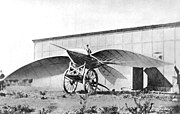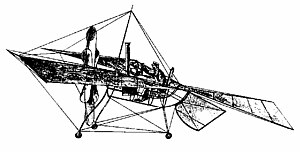Toward better understanding
 The first published paper on aviation was "Sketch of a Machine for Flying in the Air" by Emanuel Swedenborg published in 1716. This flying machine consisted of a light frame covered with strong canvas and provided with two large oars or wings moving on a horizontal axis, arranged so that the upstroke met with no resistance while the downstroke provided lifting power. Swedenborg knew that the machine would not fly, but suggested it as a start and was confident that the problem would be solved. He said, "It seems easier to talk of such a machine than to put it into actuality, for it requires greater force and less weight than exists in a human body. The science of mechanics might perhaps suggest a means, namely, a strong spiral spring. If these advantages and requisites are observed, perhaps in time to come some one might know how better to utilize our sketch and cause some addition to be made so as to accomplish that which we can only suggest. Yet there are sufficient proofs and examples from nature that such flights can take place without danger, although when the first trials are made you may have to pay for the experience, and not mind an arm or leg." Swedenborg would prove prescient in his observation that powering the aircraft through the air was the crux of flying.
The first published paper on aviation was "Sketch of a Machine for Flying in the Air" by Emanuel Swedenborg published in 1716. This flying machine consisted of a light frame covered with strong canvas and provided with two large oars or wings moving on a horizontal axis, arranged so that the upstroke met with no resistance while the downstroke provided lifting power. Swedenborg knew that the machine would not fly, but suggested it as a start and was confident that the problem would be solved. He said, "It seems easier to talk of such a machine than to put it into actuality, for it requires greater force and less weight than exists in a human body. The science of mechanics might perhaps suggest a means, namely, a strong spiral spring. If these advantages and requisites are observed, perhaps in time to come some one might know how better to utilize our sketch and cause some addition to be made so as to accomplish that which we can only suggest. Yet there are sufficient proofs and examples from nature that such flights can take place without danger, although when the first trials are made you may have to pay for the experience, and not mind an arm or leg." Swedenborg would prove prescient in his observation that powering the aircraft through the air was the crux of flying.
 The first published paper on aviation was "Sketch of a Machine for Flying in the Air" by Emanuel Swedenborg published in 1716. This flying machine consisted of a light frame covered with strong canvas and provided with two large oars or wings moving on a horizontal axis, arranged so that the upstroke met with no resistance while the downstroke provided lifting power. Swedenborg knew that the machine would not fly, but suggested it as a start and was confident that the problem would be solved. He said, "It seems easier to talk of such a machine than to put it into actuality, for it requires greater force and less weight than exists in a human body. The science of mechanics might perhaps suggest a means, namely, a strong spiral spring. If these advantages and requisites are observed, perhaps in time to come some one might know how better to utilize our sketch and cause some addition to be made so as to accomplish that which we can only suggest. Yet there are sufficient proofs and examples from nature that such flights can take place without danger, although when the first trials are made you may have to pay for the experience, and not mind an arm or leg." Swedenborg would prove prescient in his observation that powering the aircraft through the air was the crux of flying.
The first published paper on aviation was "Sketch of a Machine for Flying in the Air" by Emanuel Swedenborg published in 1716. This flying machine consisted of a light frame covered with strong canvas and provided with two large oars or wings moving on a horizontal axis, arranged so that the upstroke met with no resistance while the downstroke provided lifting power. Swedenborg knew that the machine would not fly, but suggested it as a start and was confident that the problem would be solved. He said, "It seems easier to talk of such a machine than to put it into actuality, for it requires greater force and less weight than exists in a human body. The science of mechanics might perhaps suggest a means, namely, a strong spiral spring. If these advantages and requisites are observed, perhaps in time to come some one might know how better to utilize our sketch and cause some addition to be made so as to accomplish that which we can only suggest. Yet there are sufficient proofs and examples from nature that such flights can take place without danger, although when the first trials are made you may have to pay for the experience, and not mind an arm or leg." Swedenborg would prove prescient in his observation that powering the aircraft through the air was the crux of flying.During the last years of the 18th century, Sir George Cayley started the first rigorous study of the physics of flight. In 1799 he exhibited a plan for a glider, which except for planform was completely modern in having a separate tail for control and having the pilot suspended below the center of gravity to provide stability, and flew it as a model in 1804. Over the next five decades Cayley worked on and off on the problem, during which he invented most of basic aerodynamics and introduced such terms as lift and drag. He used both internal and external combustion engines, fueled by gunpowder, but it was left to Alphonse Penaud to make powering models simple, with rubber power. Later Cayley turned his research to building a full-scale version of his design, first flying it unmanned in 1849, and in 1853 his coachman made a short flight at Brompton, near Scarborough in Yorkshire.
In 1848, John Stringfellow had a successful test flight of a steam-powered model, in Chard, Somerset, England. This was 'unmanned'.
 In 1866 a Polish peasant, sculptor and carpenter by the name of Jan Wnęk built and flew a controllable glider. Wnęk was illiterate and self-taught, and could only count on his knowledge about nature based on observation of birds' flight and on his own builder and carver skills. Jan Wnęk was firmly strapped to his glider by the chest and hips and controlled his glider by twisting the wing's trailing edge via strings attached to stirrups at his feet. Church records indicate that Jan Wnęk launched from a special ramp on top of the Odporyszów church tower; The tower stood 45 m high and was located on top of a 50 m hill, making a 95 m (311 ft) high launch above the valley below. Jan Wnęk made several public flights of substantial distances between 1866 - 1869, especially during religious festivals, carnivals and New Year celebrations. Wnęk left no known written records or drawings, thus having no impact on aviation progress. Recently, Professor Tadeusz Seweryn, director of the Kraków Museum of Ethnography, has unearthed church records with descriptions of Jan Wnęk's activities.
In 1866 a Polish peasant, sculptor and carpenter by the name of Jan Wnęk built and flew a controllable glider. Wnęk was illiterate and self-taught, and could only count on his knowledge about nature based on observation of birds' flight and on his own builder and carver skills. Jan Wnęk was firmly strapped to his glider by the chest and hips and controlled his glider by twisting the wing's trailing edge via strings attached to stirrups at his feet. Church records indicate that Jan Wnęk launched from a special ramp on top of the Odporyszów church tower; The tower stood 45 m high and was located on top of a 50 m hill, making a 95 m (311 ft) high launch above the valley below. Jan Wnęk made several public flights of substantial distances between 1866 - 1869, especially during religious festivals, carnivals and New Year celebrations. Wnęk left no known written records or drawings, thus having no impact on aviation progress. Recently, Professor Tadeusz Seweryn, director of the Kraków Museum of Ethnography, has unearthed church records with descriptions of Jan Wnęk's activities. In 1856, Frenchman Jean-Marie Le Bris made the first flight higher than his point of departure, by having his glider "L'Albatros artificiel" pulled by a horse on a beach. He reportedly achieved a height of 100 meters, over a distance of 200 meters.
In 1856, Frenchman Jean-Marie Le Bris made the first flight higher than his point of departure, by having his glider "L'Albatros artificiel" pulled by a horse on a beach. He reportedly achieved a height of 100 meters, over a distance of 200 meters.In 1874, Félix du Temple built the "Monoplane", a large plane made of aluminium in Brest, France, with a wingspan of 13 meters and a weight of only 80 kilograms (without the driver). Several trials were made with the plane, and it is generally recognized that it achieved lift off under its own power after a ski-jump run, glided for a short time and returned safely to the ground, making it the first successful powered flight in history, although the flight was only a short distance and a short time.
 Another person who advanced the art of flying was Francis Herbert Wenham, who unsuccessfully attempted to build a series of unmanned gliders. During his work he found that the majority of the lift from a bird-like wing appeared to be generated at the front, and concluded that long, thin wings would be better than the bat-like ones suggested by many, because they would have more leading edge for their weight. Today this measure is known as aspect ratio. He presented a paper on his work to the newly formed Royal Aeronautical Society of Great Britain in 1866, and decided to prove it by building the world's first wind tunnel in 1871. Members of the Society used the tunnel and learned that cambered wings generated considerably more lift than expected by Cayley's Newtonian reasoning, with lift-to-drag ratios of about 5:1 at 15 degrees. This clearly demonstrated the ability to build practical heavier-than-air flying machines; what remained was the problem of powering them, and controlling the flight.
Another person who advanced the art of flying was Francis Herbert Wenham, who unsuccessfully attempted to build a series of unmanned gliders. During his work he found that the majority of the lift from a bird-like wing appeared to be generated at the front, and concluded that long, thin wings would be better than the bat-like ones suggested by many, because they would have more leading edge for their weight. Today this measure is known as aspect ratio. He presented a paper on his work to the newly formed Royal Aeronautical Society of Great Britain in 1866, and decided to prove it by building the world's first wind tunnel in 1871. Members of the Society used the tunnel and learned that cambered wings generated considerably more lift than expected by Cayley's Newtonian reasoning, with lift-to-drag ratios of about 5:1 at 15 degrees. This clearly demonstrated the ability to build practical heavier-than-air flying machines; what remained was the problem of powering them, and controlling the flight.
ไม่มีความคิดเห็น:
แสดงความคิดเห็น